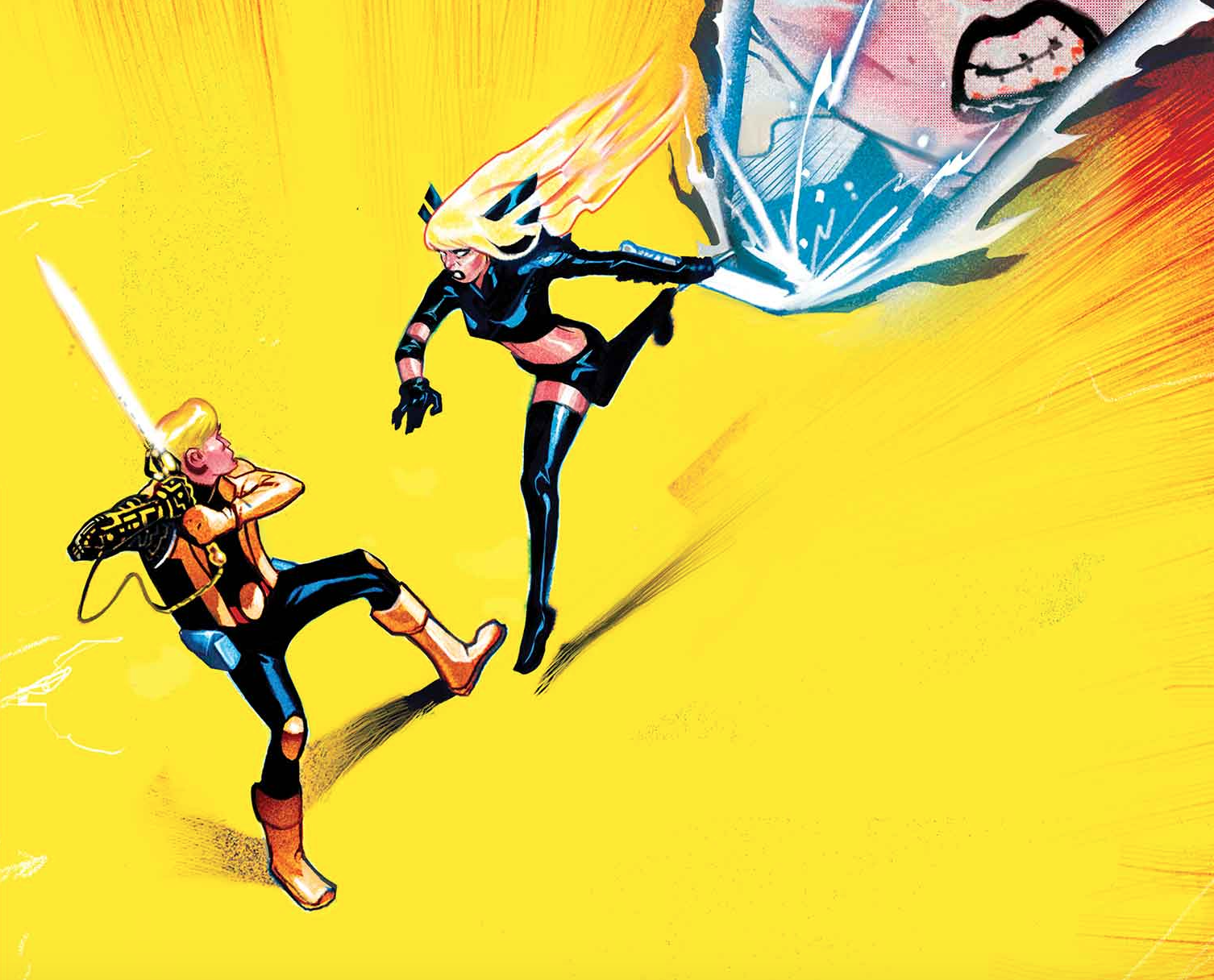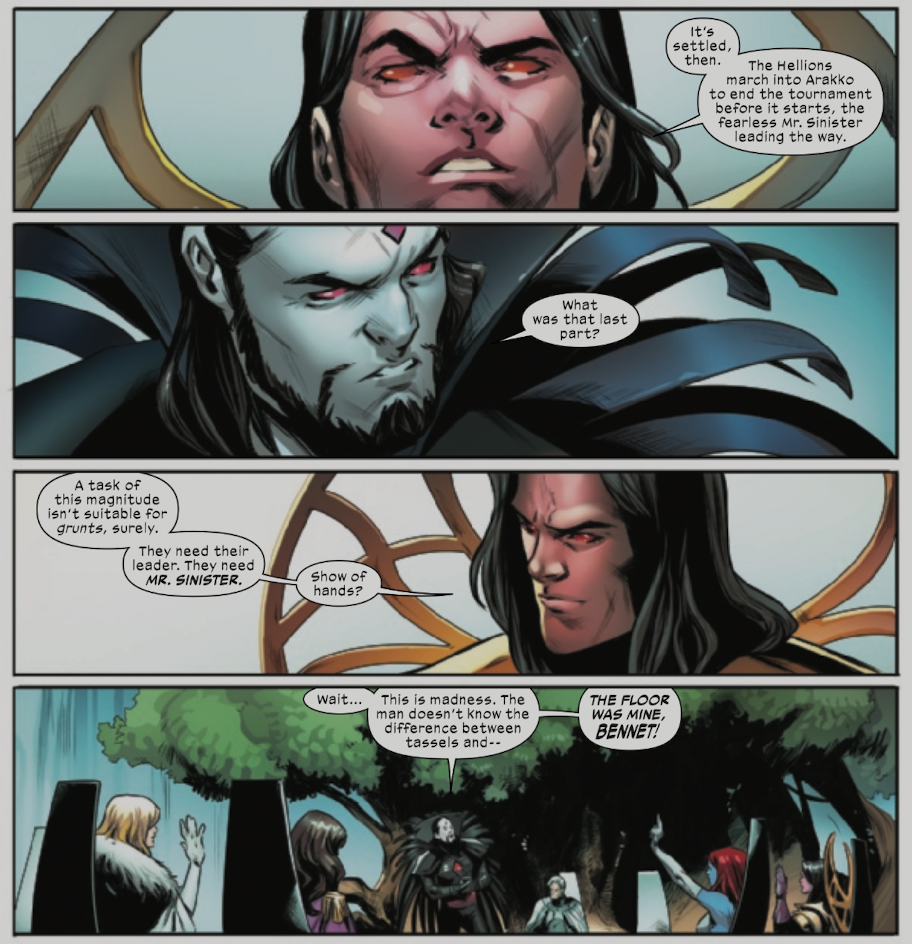A Losing Battle
“X of Swords Chapter 17”
X-Force #14
Written by Benjamin Percy and Gerry Duggan
Art by Joshua Cassara
Color art by Guru-eFX
“X of Swords Chapter 18”
Hellions #6
Written by Zeb Wells
Art by Carmen Carnero
Color art by David Curiel
“X of Swords Chapter 19”
Cable #7
Written by Gerry Duggan
Art by Phil Noto
• The last seven pages of X-Force #14 is, as far as I’m concerned, the best Storm story published in over 30 years. The plot echoes a few classic motifs – she’s stripped of her powers and is forced to rely on her wits and fighting skills in a duel – but the weight of it feels different, like we’re seeing something new in her that reinforces important elements that have been there all along. Storm and Death, who had an odd sort of courtship dance earlier in the story, are forced to duel in Sevalith, a realm of vampires. Death is courteous but condescending, and even in a powerless and inebriated state Storm takes advantage of his arrogance and reflects his death gaze back on him before stabbing him in the heart. She leaves him bleeding out, and invites the vampires of Sevalith to feast on his blood. This move sums up the Storm of 2020 – as brutal as she is regal, and a woman who has now conquered literal and figurative death twice in the past three months of publishing.
It’s worth noting Storm has a history with vampires, Dracula in particular, and that Death is an ancient Egyptian man who dresses as Anubis, which connects to her childhood in Cairo. Storm’s sword Skybreaker – the sacred blade which she stole from Black Panther in the first act – is established as a conduit that can convert small amounts of energy back as larger amounts, which explains how she could reflect Death’s death gaze back on him in such a devastating way. The sword is also explained as a weapon passed down through Wakanda through generations to protect the fledgling nation. And of course, that purpose carries over here, but in defense of Krakoa.
• The two issues of Hellions in X of Swords are essentially a side quest that can easily be read out of context, particularly as the issues do more to advance the plot of that series than that of the crossover. As we see in this issue, the group’s mission as established last month is not only a total failure, but nothing but a ruse for Mister Sinister to collect the genetic materials of mutants in Arakko. And of course that’s what he’d do! It’s his whole deal. But the plot hits a snag as Sinister meets his opposite number – Tarn the Uncaring, a mutant from Amenth who can warp the mutations of others and has become a deranged cross between an artist and a cult leader. His horrific creations the Locus Vile tear through the Hellions with ease, and before Sinister can make it back to Krakoa with his genetic data, Tarn does…something…to his body. It should be interesting to see what happens to this Sinister body, which we already know is a duplicate.
We will surely be seeing Tarn and the Locus Vile again in this series – you definitely don’t go out of your way to create characters this disturbing unless you plan on making the most of a crew that’s a dark mirror of your exceedingly warped and broken cast of protagonists. I like that Tarn and Sinister have the same sort of cavaliar god complex, but the difference between them essentially comes down to art/religion vs science. Wells’ text page describing the Locus Vile is excellent in selling the characters’ unnerving premises, from Sick Bird’s fascination with invading the “sacred cord” of the spine to truly “know” her prey to the unexplained but clearly dire consequences of what happens when Amino Fetus eats.
• The duel between Gorgon and The White Sword in Cable #6 is another instant classic fight scene, as one of the great Captains of Krakoa dies with honor after slaughtering over a dozen of the ancient mutant’s slave warriors, which evens the score in Saturnyne’s contest after several issues of the X-Men getting demolished by the Arakki. Phil Noto sells the drama of this scene very well with clean, uncluttered pages that convey Gorgon’s exceptional grace as a warrior.
Gorgon was introduced as a Wolverine villain by Mark Millar and John Romita Jr in the 2000s, and since then has mainly appeared in two of Jonathan Hickman’s more obscure Marvel works, Secret Warriors and Avengers World. Up until very recently he was played as vicious criminal genius affiliated with The Hand, Hydra, and HAMMER. Aside from X-Men #4, in which we see him act as a bodyguard for Xavier, Magneto, and Apocalypse, X of Swords is his first big moment as a protagonist in an X-Men story. This scene does two major things for the character – it gives him a set piece that proves his nobility, bravery, and extraordinary fighting skills, and it hits a reset button that allows him to be resurrected without the baggage of his worst deeds. I imagine that when we meet the new Gorgon, with his old self overwritten by a composite of his many selves throughout the multiverse, we’ll be meeting someone who isn’t far off from the man we see in this issue.
• Nanny, Orphan Maker, and Wild Child also die in Otherworld, which essentially means that Zeb Wells gets an opportunity to define those characters going forward on his terms. This should be fascinating for Nanny and the Orphan Maker, who were already very undeveloped and enigmatic characters. Will they even be able to recognize one another on the other side?
Edit: I’ve been corrected in the comments that they actually died in Arakko/Amenth, so presumably the Otherworld death scramble effect won’t apply to them. This makes sense given that Wells has established a Nanny subplot in previous issues and he probably wouldn’t just throw that away.
• Some very good funny bits in these issues, from the silliness of some of the competitions to the reveal that Pogg Ur-Pogg is just a little troll hiding inside a big alligator monster, and the bit where Cable explains to his very confused parents that he was just beaten by “Doug’s large wife.”














